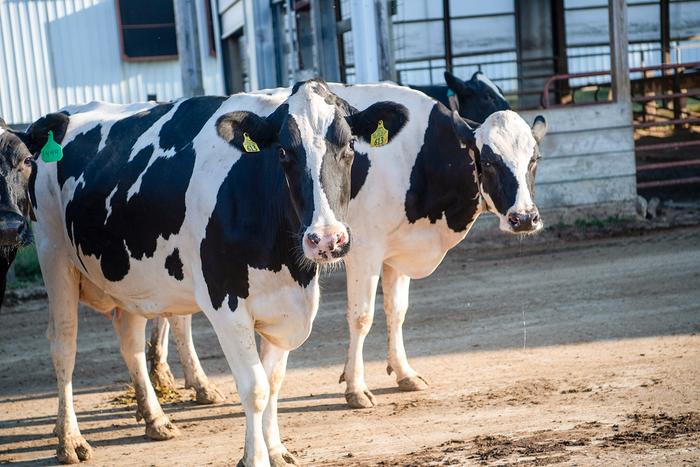Extreme weather events are wreaking havoc on livestock agriculture, with a recent study from the University of Illinois Urbana-Champaign shining a spotlight on the impacts of heat stress on dairy cows. Researchers conducted an extensive analysis, revealing that high temperatures and humidity can lead to a staggering 1% decline in annual milk production. The findings indicate that small farms face more dire consequences compared to their larger counterparts, who often have more resources to implement effective management strategies.
The consequence of heat stress in dairy cows is not merely a statistical concern; it translates into tangible economic losses for producers. When cows are subjected to excessive heat, they experience a range of detrimental effects similar to humans. The stress manifests as reduced appetite, increased likelihood of infections, and restlessness, which all contribute to diminished milk yield. According to Marin Skidmore, an assistant professor at the University of Illinois and co-author of the study, the economic implications of this reduction in milk yield are substantial, presenting a direct threat to dairy farm revenues.
The study draws from a significant pool of data, encompassing over 56 million individual production records from dairy herds across nine states in the Midwest. By assessing data from 18,000 farms collected between 2012 and 2016, researchers were able to create a comprehensive overview of milk production trends amidst varying climatic conditions. The milk yield figures were adjusted for quality—accounting for essential factors such as protein and fat content—to reflect a more accurate measure of revenue generation.
Historically, the focus of research in this area has been limited to fluid milk yield. However, as Skidmore notes, the dairy marketing system operates on the sale of milk components. This means that, beyond just the volume of milk produced, the profitability hinges on the quality of that milk, which is influenced by environmental factors like heat stress. To develop a fuller picture of climate effects, researchers combined quality-adjusted production metrics with daily weather data regarding temperature and humidity.
The findings suggest that even a mere 1% loss in milk production may appear insignificant at first glance; however, when scaled up, it represents an astonishing 1.4 billion pounds of milk over a five-year period across the studied herds. This loss translates into an estimated $245 million in lost revenue, a significant blow to farmers already facing challenges in a competitive market.
Further investigation into the data revealed that smaller farms—those with fewer than 100 cows—are disproportionately affected by heat stress. Although they contribute to less than 20% of total milk output among the analyzed herds, they account for a staggering 27% of total revenue losses. These stats underscore the vulnerability of smaller operations, which may lack the resources and infrastructure to implement adequate heat stress mitigation strategies.
Despite these mitigation strategies, no single solution can fully eradicate the negative effects of heat stress. Skidmore points out that the complexity of livestock management means that while some adaptive methods may handle lower heat stress levels, there exists a threshold beyond which effectiveness wanes dramatically. As heat and humidity climb, the situation escalates beyond the reach of even the most sophisticated management interventions.
Looking ahead, the research team has projected potential losses related to dairy production through to the year 2050. By pulling from data derived from 22 different climate models, they determined that extreme heat events are expected to increase significantly. Under most climate scenarios, losses in milk yield are predicted to increase by approximately 30% by mid-century, raising urgent questions about future sustainability in dairy farming.
Achieving a balance between sustainable dairy production and the protection of farmers is crucial in the face of climate variability. The study not only delineates the current challenges posed by heat stress but also emphasizes the need for actionable solutions. The urgency for financial assistance, research funding, and shared resources within the agricultural community becomes evident as we navigate an uncertain climatic future. As the dairy industry grapples with these pressing issues, the role of collaborative effort cannot be overstated, making clear that addressing these challenges will require partnership, innovation, and resilience.
The findings of the study, which highlight the interconnectedness of climate change and agricultural economics, propel the dialogue forward and urge stakeholders throughout the dairy supply chain to explore new strategies for resilience. Only through a concerted effort can the dairy community hope to weather the storms, both literal and metaphorical, that lie ahead in a warming world.
Subject of Research: The impact of heat stress on dairy milk production
Article Title: Vulnerability of US dairy farms to extreme heat
News Publication Date: 10-Feb-2025
Web References: Link to the publication
References: Skidmore, Marin, Hutchins, Jared, Nolan, Derek. (2025). Vulnerability of US dairy farms to extreme heat. Food Policy. DOI: 10.1016/j.foodpol.2025.102821
Image Credits: College of ACES
Keywords: Agriculture, Dairy, Climate Change, Animal Science, Dairy Production, Heat Stress, Small Farms, Economic Impact, Sustainability.
Tags: climate adaptation in dairy farmingdairy cow health and productivityeconomic impact of climate change on dairyextreme heat effects on dairy productionheat stress on livestocklivestock agriculture and extreme weathermanagement strategies for heat stressMidwest dairy industry challengesmilk production decline due to heatsmall farms in agricultureUniversity of Illinois research on dairyvulnerability of small dairy farms





